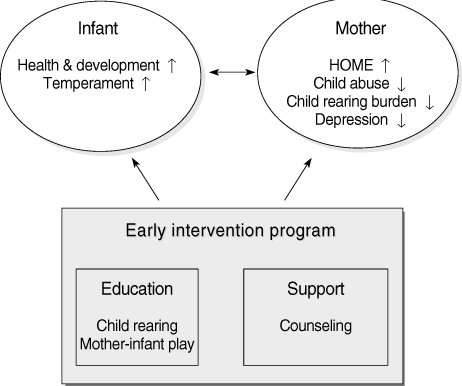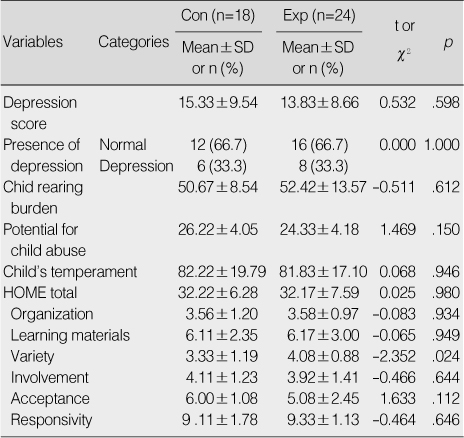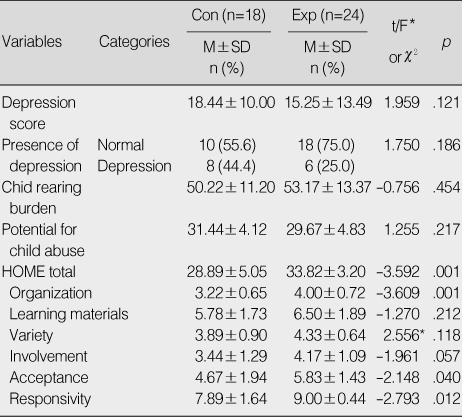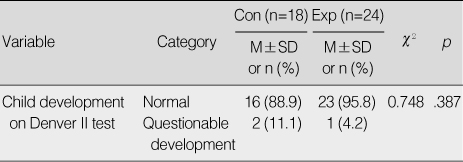Articles
- Page Path
- HOME > J Korean Acad Nurs > Volume 39(6); 2009 > Article
-
Original Article
- Effects of an Early Nursing Intervention Program for Infants' Development and Mother's Child Rearing in Poverty
- Kyung-Sook Bang
-
Journal of Korean Academy of Nursing 2009;39(6):796-804.
DOI: https://doi.org/10.4040/jkan.2009.39.6.796
Published online: December 31, 2009
Associate Professor, College of Nursing, Ajou University, Suwon, Korea.
- Address reprint requests to: Bang, Kyung-Sook. College of Nursing, Ajou University, San 5 Woncheon-dong, Youngtong-gu, Suwon 443-721, Korea. Tel: 82-31-219-7016, Fax: 82-31-219-7020, ksbang@ajou.ac.kr
Copyright © 2009 Korean Society of Nursing Science
Figure & Data
REFERENCES
Citations

- Home visit-based baby tailored support program for infants
Hyeji Shin, Yoonjung Kim, Jeonghyun Choi
Journal of Pediatric Nursing.2025; 80: 1. CrossRef - Effect of a Follow-up Program Involving an Early Intervention and Self-help Group on Parenting Stress, Depression, and Parenting Efficacy for Mothers of Premature Infants
Eun Sun Ji, Jinhee Choi, Kaka Shim
Journal of The Korean Society of Maternal and Child Health.2023; 27(4): 256. CrossRef - The Seoul Healthy First Step Project: Introduction and Expansion, Program Content and Performance, and Future Challenges
Young-Ho Khang, Hong Jun Cho, leejiyun, 김유미, 조성현, Kyung Ja June
JOURNAL OF THE KOREAN SOCIETY OF MATERNAL AND CHILD HEALTH.2018; 22(2): 63. CrossRef - An Integrative Review of Home Care Service for Pregnant Women, Mothers, Infants, and Toddlers in Vulnerable Group
Dasom Kim, Insook Lee
Journal of Korean Academy of Nursing.2017; 47(5): 577. CrossRef - Ages and Stages Questionnaire: a global screening scale
Ajay Singh, Chia Jung Yeh, Sheresa Boone Blanchard
Boletín Médico del Hospital Infantil de México.2017; 74(1): 5. CrossRef - Ages and Stages Questionnaire: a global screening scale
Ajay Singh, Chia Jung Yeh, Sheresa Boone Blanchard
Boletín Médico Del Hospital Infantil de México (English Edition).2017; 74(1): 5. CrossRef - The Effect of a Postpartum Nursing Intervention Program for Immigrant Mothers.
Kyung Sook Bang, Bo Yun Huh, Mi Kyung Kwon
Child Health Nursing Research.2014; 20(1): 11. CrossRef - Psychosocial and psychological interventions for preventing postpartum depression
Cindy-Lee Dennis, Therese Dowswell
Cochrane Database of Systematic Reviews.2013;[Epub] CrossRef - The Development of Infants from Low-Income Families, Parenting Characteristics, and Daily Routines
Hanna Kang, Hyewon Park
Family and Environment Research.2013; 51(6): 613. CrossRef - Effects of an Infant/Toddler Health Program on Parenting Knowledge, Behavior, Confidence, and Home Environment in Low-income Mothers
Gyungjoo Lee, Soo Yang, Mi Heui Jang, Mijung Yeom
Journal of Korean Academy of Nursing.2012; 42(5): 671. CrossRef - Effects of Active Parenting Today based on Goal Attainment Theory on Parenting Stress, Parenting Behavior, and Parenting Satisfaction in Mothers of School-Age Children
Kyung Im Park, Sangeun Oh
Journal of Korean Academy of Nursing.2012; 42(5): 659. CrossRef - Evaluation of Physical Growth and Developmental Status of Infants and Children of Married Immigrant Women in Rural Areas
Tae Im Kim, Mi Jong Kim, Yun Jung Kwon, Man Kil Jun
Journal of Korean Academy of Child Health Nursing.2010; 16(2): 164. CrossRef

Figure 1
Homogeneity Test for General Characteristics between Control and Experimental Group (N=42)
Con=control group; Exp=experimental group.
Homogeneity Test for Pre-test Scores between Control and Experimental Group (N=42)
Con=control group; Exp=experimental group; HOME=Home Observation for Measurement of the Environment.
Homogeneity Test for Child Development Pre-test between Control and Experimental Group (N=42)
Con=control group; Exp=experimental group.
Comparisons of Post-test Scores between Control and Experimental Group (N=42)
*ANCOVA (covariate: variety pre-test score).
Con=control group; Exp=experimental group; HOME=Home Observation for Measurement of the Environment.
Comparisons of Post-test Child Development between Control and Experimental Group (N=42)
Con=control group; Exp=experimental group.
Con=control group; Exp=experimental group.
Con=control group; Exp=experimental group; HOME=Home Observation for Measurement of the Environment.
Con=control group; Exp=experimental group.
*ANCOVA (covariate: variety pre-test score). Con=control group; Exp=experimental group; HOME=Home Observation for Measurement of the Environment.
Con=control group; Exp=experimental group.
 KSNS
KSNS
 E-SUBMISSION
E-SUBMISSION






 Cite
Cite

